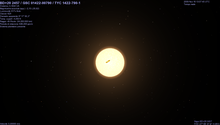| Revision as of 19:14, 21 April 2021 editLithopsian (talk | contribs)Autopatrolled, Extended confirmed users, New page reviewers68,720 edits other missing refs← Previous edit | Revision as of 03:36, 29 July 2021 edit undoMary calist mlay (talk | contribs)Extended confirmed users601 edits Adding picture #WPWP #WPWPARK #WPWPTZTag: Wikimedia image contest entryNext edit → | ||
| Line 45: | Line 45: | ||
| }} | }} | ||
| {{Starbox end}} | {{Starbox end}} | ||
| ] | |||
| '''BD+20 2457''' is a 10th-] ] ] ] located approximately 5,400 ]s away<ref name="Gaia DR2"/> in the ] of ]. This star is very metal-poor, containing only 10% as enriched with elements heavier than hydrogen and helium as our sun. On June 10, 2009, two planets were announced to be orbiting the star, with minimum masses 21.4 and 12.5 times the mass of Jupiter and orbital periods of 380 and 622 days for the inner and outer planets, respectively.<ref name="Niedzielski2009"/> A dynamical analysis reveals that the proposed system is unstable on astronomically-short timescales and so the suggested planetary configuration is unlikely to be correct: further data is needed to determine a physically-plausible explanation for the radial velocity variations.<ref name="Horner2014"/> | '''BD+20 2457''' is a 10th-] ] ] ] located approximately 5,400 ]s away<ref name="Gaia DR2"/> in the ] of ]. This star is very metal-poor, containing only 10% as enriched with elements heavier than hydrogen and helium as our sun. On June 10, 2009, two planets were announced to be orbiting the star, with minimum masses 21.4 and 12.5 times the mass of Jupiter and orbital periods of 380 and 622 days for the inner and outer planets, respectively.<ref name="Niedzielski2009"/> A dynamical analysis reveals that the proposed system is unstable on astronomically-short timescales and so the suggested planetary configuration is unlikely to be correct: further data is needed to determine a physically-plausible explanation for the radial velocity variations.<ref name="Horner2014"/> | ||
Revision as of 03:36, 29 July 2021
Star in the constellation Leo| Observation data Epoch J2000.0 Equinox J2000.0 | |
|---|---|
| Constellation | Leo |
| Right ascension | 10 16 44.8673 |
| Declination | +19° 53′ 29.0096″ |
| Apparent magnitude (V) | 9.75 |
| Characteristics | |
| Spectral type | K2II |
| B−V color index | +1.25 |
| Astrometry | |
| Proper motion (μ) | RA: −36.077±0.094 mas/yr Dec.: −29.942±0.093 mas/yr |
| Parallax (π) | 0.5985 ± 0.0797 mas |
| Distance | approx. 5,400 ly (approx. 1,700 pc) |
| Details | |
| Mass | 2.8±1.5 M☉ |
| Radius | 49±26 R☉ |
| Luminosity | 1,479 L☉ |
| Surface gravity (log g) | 1.51 cgs |
| Temperature | 4,127±17 K |
| Metallicity | −1.00±0.07 dex |
| Other designations | |
| PPM 127264 | |
| Database references | |
| SIMBAD | data |
| Exoplanet Archive | data |

BD+20 2457 is a 10th-magnitude K-type bright giant star located approximately 5,400 light-years away in the constellation of Leo. This star is very metal-poor, containing only 10% as enriched with elements heavier than hydrogen and helium as our sun. On June 10, 2009, two planets were announced to be orbiting the star, with minimum masses 21.4 and 12.5 times the mass of Jupiter and orbital periods of 380 and 622 days for the inner and outer planets, respectively. A dynamical analysis reveals that the proposed system is unstable on astronomically-short timescales and so the suggested planetary configuration is unlikely to be correct: further data is needed to determine a physically-plausible explanation for the radial velocity variations.
References
- ^ Brown, A. G. A.; et al. (Gaia collaboration) (August 2018). "Gaia Data Release 2: Summary of the contents and survey properties". Astronomy & Astrophysics. 616. A1. arXiv:1804.09365. Bibcode:2018A&A...616A...1G. doi:10.1051/0004-6361/201833051. Gaia DR2 record for this source at VizieR.
- ^ Niedzielski, A.; et al. (2009). "Substellar-mass Companions to the K-dwarf BD+14 4559 and the K-giants HD 240210 and BD+20 2457". The Astrophysical Journal. 707 (1): 768–777. arXiv:0906.1804. Bibcode:2009ApJ...707..768N. doi:10.1088/0004-637X/707/1/768. S2CID 16877069.
- Horner, J.; Wittenmyer, R. A.; Hinse, T. C.; Marshall, J. P. (2014). "A dynamical investigation of the proposed BD +20 2457 system". Monthly Notices of the Royal Astronomical Society. 439 (1): 1176–1181. arXiv:1401.2793. Bibcode:2014MNRAS.439.1176H. doi:10.1093/mnras/stu081. S2CID 54534748.
{{cite journal}}: CS1 maint: unflagged free DOI (link)
| Constellation of Leo | |||||||||||||
|---|---|---|---|---|---|---|---|---|---|---|---|---|---|
| Stars |
| ||||||||||||
| |||||||||||||
| Galaxies |
| ||||||||||||
| |||||||||||||
This giant-star-related article is a stub. You can help Misplaced Pages by expanding it. |
This extrasolar-planet-related article is a stub. You can help Misplaced Pages by expanding it. |